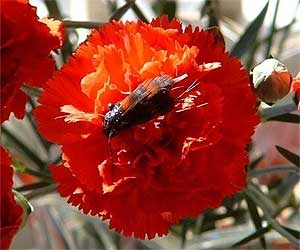Dan Fallon's April 2010 Fly Fishing Column
Dan Fallon's April 2010 Fly Fishing Column
By Dan Fallon
Californicus Caninus Mothnatives
 Here in the land of milk and honey this particular spring has already arrived with the most exciting array of wildflowers growing near all my favorite creeks and streams. This is a perfect setting to experiment with a new mind-set instead of your assembly of tried and true fly patterns. Leave that fly box home and try experimenting with new patterns based solely on what you see flying, crawling, living and dying near your favorite fly waters This months rather odd pattern is my “ Wolf Moth ‘ which is really a composite of every moth and common fly I see near creeks and streams with abundant wildflowers. Californicus Caninus Mothnatives is my Frankenstein attractor bug that never fails to catch the attention of any Rainbow, Brook Trout that watches it fall, tumble off the flowers I choose to bounce it off gently before it hits the water. Simply by changing the color of the wings or the size of its eyes or length of its coal black antenna, almost any creek or stream anywhere will work with this buggy realistic pattern. It has been used from Europe to California, especially when nothing else is working. I change sizes by using hooks ( always barbless of course! ) from small salmon egg trout hooks to whatever size is needed.
Here in the land of milk and honey this particular spring has already arrived with the most exciting array of wildflowers growing near all my favorite creeks and streams. This is a perfect setting to experiment with a new mind-set instead of your assembly of tried and true fly patterns. Leave that fly box home and try experimenting with new patterns based solely on what you see flying, crawling, living and dying near your favorite fly waters This months rather odd pattern is my “ Wolf Moth ‘ which is really a composite of every moth and common fly I see near creeks and streams with abundant wildflowers. Californicus Caninus Mothnatives is my Frankenstein attractor bug that never fails to catch the attention of any Rainbow, Brook Trout that watches it fall, tumble off the flowers I choose to bounce it off gently before it hits the water. Simply by changing the color of the wings or the size of its eyes or length of its coal black antenna, almost any creek or stream anywhere will work with this buggy realistic pattern. It has been used from Europe to California, especially when nothing else is working. I change sizes by using hooks ( always barbless of course! ) from small salmon egg trout hooks to whatever size is needed.
Tiny Terrestrial Insect Presentation Technique’s
 Seasoned fly fisher or first year novice, learning how to present very small flying insects takes getting used to. First, unlike the usual dry flies which are drifted in currents and skipped and worked to look as if they died and are now captured in moving water so trout are not spooked and consider your offering a natural resident energy source. Tiny flies like my moth live and die with exceptions within the confines of wildflowers. That is why they need to be presented as if they accidently fell either out of over hanging tree limbs or tumbled from flowers on the waters edge.The following technique works for all known terrestrials. If possible use the High Stick method where you let out several feet of tippet and hold your fly rod high as possible and let the insect fall straight down on fairly quiet water near creek, stream edges and then just let it twist and stop in any cadence you like fast or slow. The movement of the water gently splashing will attract resident trout who know an easy morsel can be eaten. It does not help to drift the Moth, Bumble Bee, Black Fly, Ant, as it is not a natural occurrence. These are oppertunity foods and need special presentation. I often climb trees when working my Wolf Moth, letting several feet of tippet fall straight down and then I slowly bounce and twist the Moth, it is great fun to engage another natural trout feeding response effective on wild or hatchery trout. This technique takes time and practice to master, first spend time watching what happens to insects near water edges. The idea is to replicate with as much exactness as possible the natural behavior of resident insects. It is what seperates journeyman fly fishers from every other sportsmen! We actually have to think.
Seasoned fly fisher or first year novice, learning how to present very small flying insects takes getting used to. First, unlike the usual dry flies which are drifted in currents and skipped and worked to look as if they died and are now captured in moving water so trout are not spooked and consider your offering a natural resident energy source. Tiny flies like my moth live and die with exceptions within the confines of wildflowers. That is why they need to be presented as if they accidently fell either out of over hanging tree limbs or tumbled from flowers on the waters edge.The following technique works for all known terrestrials. If possible use the High Stick method where you let out several feet of tippet and hold your fly rod high as possible and let the insect fall straight down on fairly quiet water near creek, stream edges and then just let it twist and stop in any cadence you like fast or slow. The movement of the water gently splashing will attract resident trout who know an easy morsel can be eaten. It does not help to drift the Moth, Bumble Bee, Black Fly, Ant, as it is not a natural occurrence. These are oppertunity foods and need special presentation. I often climb trees when working my Wolf Moth, letting several feet of tippet fall straight down and then I slowly bounce and twist the Moth, it is great fun to engage another natural trout feeding response effective on wild or hatchery trout. This technique takes time and practice to master, first spend time watching what happens to insects near water edges. The idea is to replicate with as much exactness as possible the natural behavior of resident insects. It is what seperates journeyman fly fishers from every other sportsmen! We actually have to think.
 WOLF MOTH
WOLF MOTH
Hook: Dry Fly # 14 - #15
Thread: Fuzzy Black or green depending on wing color.
Body: Peacock Herl wrapped to look as buggy as possible.
Wings: Green or Black is my favorties. Brown, white, red depending on where you live.
Antenne: two long black single hackle barbs ( Wings and Antenne are glued not tied )
Head: Burnt glue ball, size your choice
Legs: ( optional ) Hachle Barbs
Eyes: I use many kinds incuding BB size to change the look, painting eyes red is deadly!
* Remember Wings and Antenne are glued not tied.
 Click Here for this month's story line of Click Here for this month's story line of “ ADVENTURES OF FLETCHER QUILL “
|
